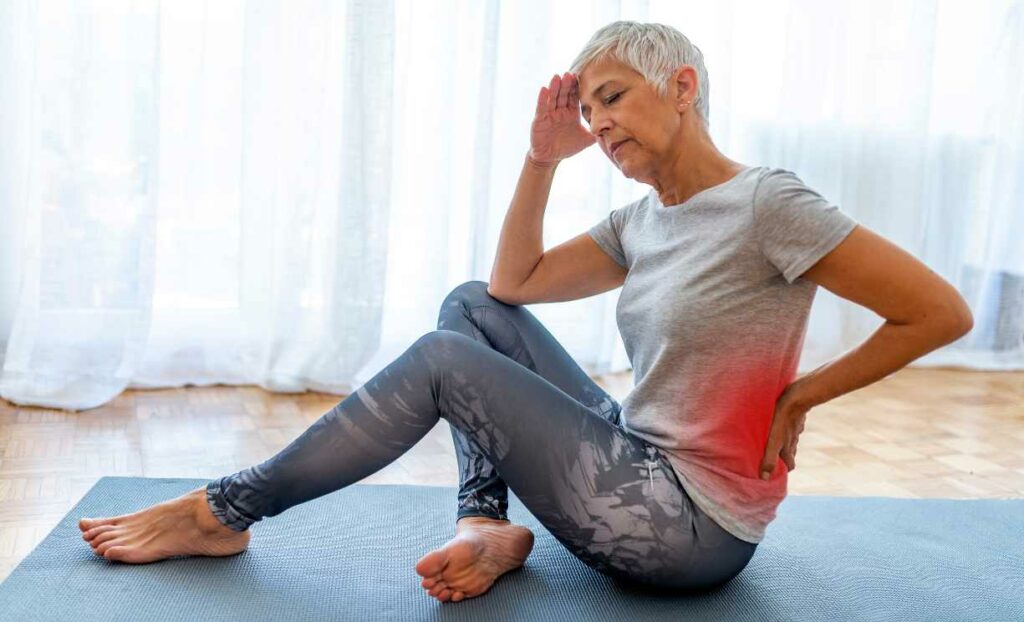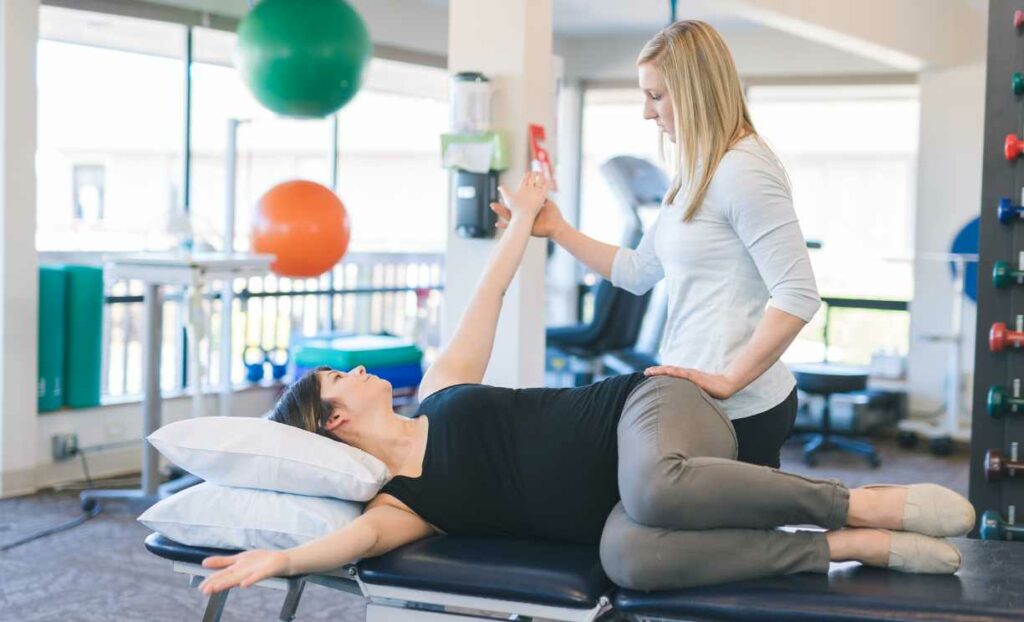Menopause is a natural phase in a woman’s life that brings about hormonal changes and various physical symptoms. One often-overlooked symptom is lower back pain, which can significantly impact daily life. In this blog, we will explore the causes of lower back pain during menopause and effective treatment options to provide relief.
Contents
Why Does Menopause Lead To Lower Back Pain?
Lower back pain during menopause can have various causes, often linked to hormonal changes, aging, and lifestyle factors. Here are common reasons why menopausal women may experience lower back pain:
- Hormonal Changes: Menopause involves a significant decrease in estrogen levels. Estrogen plays a role in maintaining bone density, and its reduction can contribute to conditions like osteoporosis, making the spine more susceptible to fractures and lower back pain.
- Osteoporosis: The decline in estrogen levels can lead to decreased bone density, increasing the risk of osteoporosis. Weakened bones, especially in the spine, can result in fractures and subsequent lower back pain.
- Joint Changes: Estrogen influences connective tissues, including those in the joints. The decline in estrogen levels may lead to changes in joint integrity, potentially causing stiffness and discomfort in the lower back.
- Disc Degeneration: Estrogen is believed to contribute to the health of intervertebral discs, the cushions between the vertebrae. The decrease in estrogen levels may contribute to disc degeneration, leading to lower back pain.
- Weight Distribution Changes: Menopausal women may experience changes in body composition, including an increase in abdominal fat. This altered weight distribution can place additional stress on the lower back, contributing to pain.
- Posture Changes: Hormonal changes, coupled with factors like aging and decreased physical activity, can contribute to changes in posture. Poor posture can strain the muscles and ligaments of the lower back, leading to pain.
- Stress and Lifestyle Factors: Menopause is often a time of significant life changes and stress. Stress can exacerbate physical symptoms, including lower back pain. Additionally, lifestyle factors such as lack of exercise and poor dietary choices can contribute to musculoskeletal issues.
- Existing Medical Conditions: Pre-existing conditions such as arthritis or herniated discs can be exacerbated during menopause, contributing to lower back pain.
Treatment For Lower Back Pain During Menopause
The treatment for lower back pain due to menopause involves a holistic approach addressing both hormonal changes and musculoskeletal factors. Here are various strategies to alleviate and manage lower back pain during menopause:
- Hormone Replacement Therapy (HRT): Hormone replacement therapy, particularly estrogen, can help mitigate the hormonal changes associated with menopause. By restoring estrogen levels, HRT may contribute to better bone density and reduce the risk of fractures, alleviating lower back pain.
- Physical Therapy: A physical therapist can design a personalized exercise program to target specific muscles and improve overall spinal health. Techniques may include stretching, strengthening exercises, and posture correction.
- Pain Medications: Over-the-counter pain relievers like nonsteroidal anti-inflammatory drugs (NSAIDs) can help manage pain and inflammation. However, long-term use should be monitored by healthcare professionals.
- Heat and Cold Therapy: Applying heat or cold packs to the affected area can help reduce inflammation, soothe muscle tension, and provide temporary relief from lower back pain.
- Mind-Body Techniques: Practices such as mindfulness meditation, deep breathing exercises, and relaxation techniques can help manage stress and improve overall well-being, indirectly impacting lower back pain.
- Maintaining a Healthy Diet: Consuming a diet rich in calcium and vitamin D supports bone health. Adequate nutrition is essential for preventing osteoporosis and reducing the risk of fractures that can contribute to lower back pain.
- Weight Management: Maintaining a healthy weight reduces the load on the spine and can alleviate lower back pain. It also contributes to overall well-being and decreases the risk of developing musculoskeletal issues.
- Alternative Therapies: Consider complementary therapies such as acupuncture or chiropractic care under the guidance of healthcare professionals. These therapies may provide additional relief for lower back pain.
Lifestyle Changes For Managing Lower Back Pain Due To Menopause 
In addition to the treatment, making lifestyle changes is also an integral part of managing lower back pain during menopause. These adjustments can contribute to overall well-being and help alleviate musculoskeletal discomfort. Here are lifestyle changes that may be beneficial:
- Good Posture Practices: Be mindful of your posture, especially when sitting or standing for extended periods. Maintain a neutral spine position to reduce strain on the lower back. Consider ergonomic adjustments in your workspace.
- Adequate Sleep: Ensure you get sufficient, quality sleep. Proper rest is crucial for overall health, including musculoskeletal well-being. Invest in a supportive mattress and pillows that promote spinal alignment.
- Hydration and Nutrition: Stay hydrated, and maintain a balanced diet rich in calcium and vitamin D to support bone health. Adequate nutrition contributes to overall skeletal well-being.
- Quit Smoking: If you smoke, consider quitting. Smoking has been linked to decreased bone density, which can exacerbate musculoskeletal issues and increase the risk of lower back pain.
- Regular Stretching: Incorporate regular stretching exercises into your routine to maintain flexibility and prevent stiffness in the muscles supporting the spine.
- Comfortable Footwear: Wear supportive and comfortable shoes, especially if you spend extended periods on your feet. Proper footwear can contribute to better posture and reduce strain on the lower back.
- Stay Active Throughout the Day: Avoid prolonged periods of inactivity. If you have a sedentary job, take breaks to stretch and move around. Gentle movements can prevent stiffness and discomfort.
- Stay Informed and Seek Support: Educate yourself about menopause and its impact on musculoskeletal health. Seek support from healthcare professionals, including physical therapists and nutritionists, to tailor lifestyle changes to your specific needs.
Exercises For Lower Back Pain Due To Menopause
Exercising regularly can be an effective way to manage lower back pain during menopause. These exercises focus on strengthening the core, improving flexibility, and supporting overall spinal health. Before starting any exercise routine, it’s essential to consult with healthcare professionals, especially if you have pre-existing health conditions. Here are some exercises that may help alleviate lower back pain:
Pelvic Tilts
- Lie on your back with your knees bent and feet flat on the floor.
- Tighten your abdominal muscles and push your lower back into the floor.
- Hold for a few seconds, then relax.
- Repeat for 10-15 repetitions.
Cat-Cow Stretch
- Start on your hands and knees in a tabletop position.
- Inhale, arch your back and lift your head and tailbone (Cow position).
- Exhale, round your spine, and tuck your chin to your chest (Cat position).
- Repeat for 10-15 repetitions.
Child’s Pose
- Begin on your hands and knees in a tabletop position.
- Sit back on your heels, reaching your arms forward on the floor.
- Hold the stretch for 20-30 seconds, focusing on relaxing your lower back.
Bridge Exercise
- Lie on your back with your knees bent and feet flat on the floor.
- Lift your hips toward the ceiling, engaging your glutes and core.
- Hold for a few seconds, then lower your hips back down.
- Repeat for 10-15 repetitions.
Knee-to-Chest Stretch
- Lie on your back and bring one knee toward your chest, holding it with both hands.
- Hold the stretch for 20-30 seconds, then switch legs.
- Repeat for each leg.
Seated Forward Bend
- Sit with your legs extended in front of you.
- Hinge at your hips and reach forward toward your toes.
- Hold the stretch for 20-30 seconds, feeling a gentle stretch in your lower back and hamstrings.
Bird-Dog Exercise
- Start on your hands and knees in a tabletop position.
- Extend your right arm forward and left leg backward, keeping your back straight.
- Hold for a few seconds, then switch sides.
- Repeat for 10-15 repetitions on each side.
Side Plank
- Lie on your side with your elbow directly beneath your shoulder.
- Lift your hips off the ground, creating a straight line from head to feet.
- Hold for 15-30 seconds on each side.
Conclusion
In conclusion, the treatment of lower back pain during menopause requires a comprehensive and individualized approach that acknowledges the multifaceted factors contributing to this discomfort. As women undergo hormonal changes, the decline in estrogen levels can impact bone density, muscle mass, and joint health, leading to increased vulnerability to lower back pain. However, with the right treatment strategies, women can find relief and improve their overall musculoskeletal well-being.
Crucially, seeking guidance from healthcare professionals is paramount. Their expertise ensures a tailored approach that considers individual health conditions and preferences. Regular follow-ups allow for adjustments to the treatment plan, providing ongoing support and addressing evolving needs.




